how long does it take to fix an overbite
Anoverbite is the overlap or gap between the top and bottom front teeth. It's fairly common for the upper teeth to sit too far over or in front of the lower teeth, causing overbite teeth problems. Fortunately, dentists are experts in fixing this issue and now overbite correction is the second most common reason people choose toi get braces.
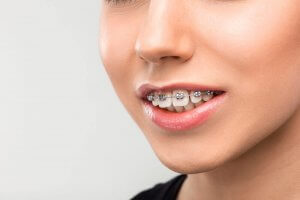
Here, we'll answer questions such as:
- What is an overbite?
- What's the difference between a normal, deep and severe overbite?
- Why should you fix overbite?
- What does treatment involve?
Keep reading to learn more about this common dental malocclusion issue and what to do if you're worried about it.
Table of contents
- 1 What is an overbite?
- 1.1 What causes an overbite
- 2 Different types of overbite
- 2.1 Overbite vs underbite
- 3 Is an overbite bad?
- 4 How to fix an overbite
- 4.1 Overbite braces
- 4.2 Invisalign for overbite
- 4.3 Overbite surgery
- 5 Summary: Before and after treatment
- 6 FAQs
- 6.1 What does an overbite look like?
- 6.2 How do I get rid of an overbite?
- 6.3 Can braces fix an overbite?
- 6.4 Does Invisalign fix deep bites and overjets?
- 6.5 Can you fix an overbite naturally?
- 6.6 Can you fix an overbite at home?
- 6.7 Can you fix an overbite without braces?
- 6.8 Can I get correction in the US with my insurance?
- 6.9 What is a normal overbite?
- 6.10 How long does it take to fix an overbite?
What is an overbite?
An overbite is the vertical overlap or horizontal gap between your top and bottom front teeth.
A horizontal overbite, also called an 'overjet', causes the upper teeth to protrude at the front of the mouth. When very pronounced, you might hear this called 'buck teeth', but we will refrain from using that term here. An overjet may occur along with an open bite, meaning there is a vertical gap between the upper and lower teeth.
When the vertical overlap is 2-4mm, or around 30% of the lower teeth are covered, this is considered a normal overbite. A deep overbite, also known as a deep bite, occurs when the overlap is 4-6mm or more. In the case of a very severe overbite, the upper teeth may completely cover the lower teeth and even dig into the lower gum.
An overbite can be both horizontal and vertical, meaning the upper teeth protrude at the front and hang too far down over the lower teeth.
The video below gives a brief visual explanation of these different dental problems including overjet vs overbite:
Braces Explained: Overbite vs Overjet In this video I will be answering the question of "what is the difference between overbite and overjet?" I've noticed a lot of people usually misterm "overjet" as "overbite" and that was my motivation for creating this video! So let's begin with overbite. Overbite is the amount your upper teeth overlap your lower teeth. If you have a big overbite that means that your upper teeth cover most of your lower teeth and you can't see them. This is referred to as a "deep bite." Sometimes you may have such a big deep bite that your lower teeth actually bite against your palate! The opposite of a big overbite is no overbite, or a reverse overbite, which is also called an open bite. This is when your upper and lower front teeth don't touch! So if that's overbite, what's overjet? Overjet is the amount of horizontal distance from your upper and lower teeth. If your upper teeth are way ahead of your lower teeth, that means you have an large overjet. This is what people often mistakenly call an overbite. If you have an underbite or, in other words, your upper front teeth are behind your lower front teeth, that is a "reverse overjet". Some overjet and overbite are normal are somewhere between 1-3mm but if you have too much, or not enough of either, it could result in unfavorable wear of your teeth, poor function, and jaw joint problems, to name a few. As always, if you have any questions or comments, please feel free to contact me via the comments below! NOW LIVE: MyOrthoLife Forum, where you can discuss your treatment, ask any questions, and connect with other patients across the world! Check it out and register to start communicating with others. Link to Forum: www.myortholife.com ! See you next time! Greg Asatrian, D.D.S., M.S. http://asatrianortho.com/ Instagram: www.instagram.com/drgregortho Linkedin: www.linkedin.com/in/gasatrian This video may contain orthodontic appliances, devices and/or procedural content. The content seen in this video is provided only for education purposes and is not intended to be a substitute for professional dental advice, diagnosis, or treatment. For personalized advice, please be sure to visit a professional orthodontist near you!
What causes an overbite
There are a few different things that might cause this dental problem. Some of the common reasons include:
- Genetics
- A jaw that doesn't form properly as a fetus
- Thumb sucking as a child
- Overusing a bottle or pacifier as a baby
- Tongue thrusting
- Nail biting
- Excessive chewing on things like pencils and pens
Different types of overbite
There are two types of overbite: skeletal and dental. The skeletal kind is caused by irregularities in jawbone development. A dental overbite occurs when there are problems with baby or adult teeth coming through, like overcrowding, or when teeth are put under pressure, for example from thumb sucking.
Overbite vs underbite
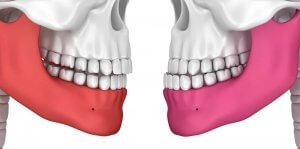
An overbite occurs when your upper jaw sits over your lower teeth, whereas an underbite occurs when your lower teeth sit in front of your upper teeth. Underbite is also known as prognathism, and has different issues and treatments associated with it. You can read more about underbite teeth here.
Is an overbite bad?
Once you understand the condition, the next step is to discover whether you need treatment. Your orthodontist will help you choose the right method of treatment for you, based on your needs. The information in the table below will help you identify whether the condition is a severe overbite vs normal, and what treatment – if any – might be needed.
| Type of overbite | Size | Cause | Requires braces? | Requires surgery? |
|---|---|---|---|---|
| Normal | 2-4mm | Usually dental | Unlikely | Highly unlikely |
| Deep | 4-8mm | Dental or skeletal | Very likely | Unlikely |
| Severe | 9mm or more | Dental or skeletal | Yes | Likely |
There are a range of reasons why it's a good idea to fix an overbite. Untreated, overbite problems can include:
- Poor dental hygiene
- Teeth wearing down quickly
- Facial pain
- Speech problems
- Poor face structure
- Temporomandibular joint (TMJ) disorders
Perhaps you are considering the options for getting rid of an overbite in your child, and are wondering whether it's worth putting them through the treatment. Bear in mind in most cases, the younger the correction takes place, the better. It can be harder to correct an overbite in adults because the jawbone and tooth roots are more firmly developed.
The process of getting braces, surgery, and then long-term retainers for an overbite might be a bit scary but the benefits of fixing misaligned teeth will outweigh the short-term discomfort during treatment.
Ask a dentist: What problems can an untreated overbite cause?
When an overbite is left untreated, the upper teeth may continue to move out of position. This can put pressure on the surrounding gums and may lead to gum recession. This recession may then lead to tooth sensitivity due to the exposed roots. Additionally, teeth may be more susceptible to chipping on their edges since the upper and bottom teeth aren't supporting each other.
Dr. Joseph Salim, Sutton Place Dental Associates
How to fix an overbite
The first thing to understand is that a normal overbite is around 2-4mm, so you don't always have to worry about your upper teeth overhanging slightly.
There are different ways your dentist might suggest correcting your bite. It will depend on how severe the problem is, and what has caused it.
Overbite braces
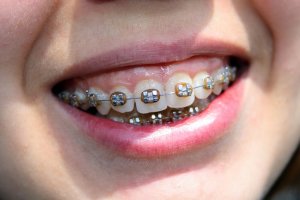
Most overbite correction in the US is done using braces. Treatment with braces is effective and, when followed up with a retainer, the results should be lifelong. This treatment can take between one and two years; sometimes more.
If getting private orthodontic treatment, you may have the option of clear teeth braces, which are less noticeable than traditional metal ones.
Before getting braces for an overbite, ask your dentist or orthodontist to show you pictures of overbites before and after braces. Knowing what a difference this treatment can make to your smile may help motivate you through the short-term discomfort! You can read more about all of the types of braces in our article here.
Invisalign for overbite
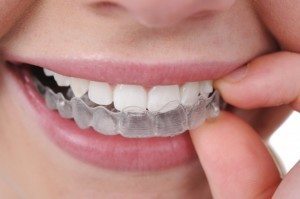
Invisalign clear aligner braces are a really effective form of overbite correction for mild and moderate cases. Although almost invisible, these braces apply pressure to move teeth to a much better position, transforming a deep overbite to a normal one. Patients usually switch to a new set of aligners every two weeks.
Treatment with Invisalign may be quicker than with regular metal braces, but the main advantage of this system is that it's almost unnoticeable. Although Invisalign for overbite is not available on Medicaid, it may be partially covered on some insurance plans and many parents are happy to pay the extra for their children to avoid 'metal mouth' taunts at school. Invisalign is also popular with adults who want to maintain a more professional appearance or have the flexibility to remove their braces.
Discover more about Invisalign and other invisible braces in our full guide.
Another type of invisible brace that may be able to correct your overbite is at-home clear aligners. This is a more affordable option that requires no in-office visits with your dentist, however, it is only suitable for mild cases. There are a variety of clear aligner brands, but not all of them offer the same quality of care and customer service. Below you can compare some of the top brands with the best care and results:
Clear aligners for overbite

There are so many companies offering remote teeth straightening with aligners! Take a look at our top picks and discover why we recommend these over any others.
Candid are leading the way in remote monitoring technology, ensuring your treatment is efficient and effective. Their orthodontist-only team follow rigorous checks when planning and conducting your treatment to give you the best results.
To get started, you can visit one of Candid's Studios for a free dental scan. Alternatively, purchase your aligner package up-front and you'll get:
- A free impression kit
- Free whitening foam
- A new, lower price of $1,895
- A full refund if you're not a good candidate
Finance is available from $65/month, and you can also buy just the starter kit to begin with.
NewSmile aligners are made from the clearest Essix plastic and come with a daytime or nighttime-only option to suit you. For just $1,295 you'll receive everything you need to straighten and whiten your teeth – and maintain your new smile:
- Home impression kit
- Full aligner treatment
- Free whitening
- First set of retainers
- A full refund if you're not a good fit
NewSmile go above and beyond to provide a great experience to all their customers, beginning with a live video call to help you with your teeth impressions. Mail these back, and they'll send a 3D Treatment Preview for you to approve before going ahead.
Use code DENTALYDEAL for an extra $100 off!
If you're looking for the best value aligner package, here it is! For just $1,145 you'll get:
- Impression kit
- Full aligner treatment course
- Free teeth whitening kit
- Your first set of retainers
In short, everything needed to straighten your teeth remotely and keep them looking great, with a full money-back guarantee if you're not a suitable candidate.
This low price doesn't mean you're compromising on quality of care, though. ALIGNERCO just choose not to put so much into marketing, and they pass on the savings to their customers. They are also known for their responsive and helpful customer care, which is important when you're doing things from home.
Plus, if you're in New York, you can visit their SmileStudio for a free consultation and help taking your impressions.
Nighttime-only aligners are also available for anyone who doesn't want to wear aligners during the day.
Use code SAVE150 for an extra $150 off!
Byte's HyperByte technology uses High Frequency Vibration to help your teeth move faster and with minimal discomfort. Their average treatment time is just 3-4 months, compared to 6 months for most others.
Treatment includes your first set of retainers. You'll also get their BrightByte 3-in-1 foam to whiten your teeth, clean your aligners and freshen your breath. And their Byte-for-life guarantee means you'll get free adjustments if your teeth start to move again.
Begin by ordering an impression kit so their orthodontists can assess whether you're a good match.
Get 75% off with code 02DENTALY100TS
Overbite surgery
A jaw set too far forward can be caused by skeletal issues in which case it usually requires correction with jaw surgery, also called orthognathic surgery. When the lower jaw, or mandible, has not developed properly, surgery can help improve the shape. You can expect your facial appearance to change slightly as a result of the surgery.
In the US, overbite surgery on CHIP or Medicaid is free of charge for children, when deemed medically necessary. Adults with a severely misaligned bite may be eligible for Medicaid treatment prices.
Overbite treatment with surgery normally involves one or more of the following:
- Removing of some teeth
- Repositioning the jaw
- Inserting screws
- Adding plates around the jaw
All of the work to fix an overbite in the jaw is done inside the mouth, so it won't leave any visible scars. Patients will probably have to stay in hospital overnight after overbite surgery, and take off work or school for 2-4 weeks. Additional orthodontic work usually takes place before and after the surgery to guide the alignment of the teeth.
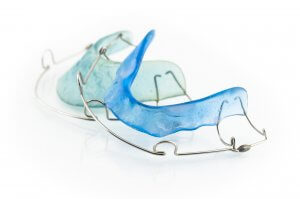
Summary: Before and after treatment
Before you fix your overbite teeth, you may be very conscious about how you look; especially if you have a severe overbite. You may also experience facial pain and headaches as a result of a deep overbite pushing back your lower jaw and putting pressure on your nerves and blood supply. You might wear your teeth down quicker because there is more strain on them.
Once you have achieved a normal overbite following correction, you might notice a change in the shape of your face because your lower jaw is further forward. This won't be extreme; you might need to look at your before and after pictures to see the difference! Any pain you may have felt should hopefully go away after your braces or surgery.
Braces can also be used to fix overbite in some cases, and if you have only a slight overbite, you may be eligible for clear aligners or invisible braces. Invisalign is the leading brand but the cost makes it unaffordable for many. If you're considering saving money with at-home aligners, take a look at our reviews of Candid, ALIGNERCO, NewSmile, and Byte to see which would be most suitable for you.
If you have had overbite braces treatment, you will need to wear a retainer afterwards to stop your teeth from moving out of position again.
FAQs
What does an overbite look like?
There are different types of overbites with different symptoms, but you may be able to tell if you have an overbite if you notice your upper teeth protruding forward more than your lower teeth. Most people have a slight overbite that is not noticeable and doesn't need treatment.
How do I get rid of an overbite?
Overbite correction is generally pretty straightforward. Dentists and orthodontists know how to correct an overbite after years of experience with this treatment in dentistry. You can:
- Get overbite braces
- Have jaw surgery
- Use clear aligners such as Invisalign
Can braces fix an overbite?
The short answer is, yes! Braces can and do fix overbites, and overbite correction with braces is the most common treatment in the US.
Does Invisalign fix deep bites and overjets?
Overbite teeth can be fixed with Invisalign in most moderate cases. The price for Invisalign overbite correction is a little higher than metal braces, but treatment may be quicker. It's also a lot less obvious to other people.
Can you fix an overbite naturally?
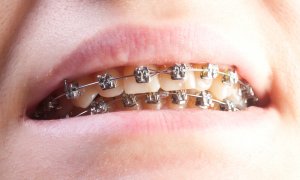
Unfortunately, you can't correct this problem naturally; you'll need overbite surgery or braces to fix it. If you have a severe overbite and want to know how to fix it, you will need to consult a dentist.
Can you fix an overbite at home?
While there is no safe way to develop your own DIY treatment plan at home, without any professional input, you can, however, opt for at-home aligners, with treatment monitored by licensed dentists.
Can you fix an overbite without braces?
Braces are the most common form of treatment for overbite correction. If you are concerned about aesthetics, invisible braces may be the best option for you. Some very severe overbites can be fixed with jaw surgery.
Can I get correction in the US with my insurance?
Children under 18 may be eligible to have overbite teeth fixed on CHIP or Medicaid with braces or surgery. As with any other treatment, approval will depend on the severity and where you live.
Adults are only likely to get braces or overbite surgery on the Medicaid if they have a severe overbite which causes problems with everyday things like eating and speaking. You can read more in our article about Medicaid dental insurance.
What is a normal overbite?
It's considered normal when the upper front teeth sit around 2-4mm in front of or overhanging the lower teeth. Research suggests that the average overbite teeth have is 2.9 mm. Around 8% of children have a deep or severe overbite of more than 6 mm. In the US, correction treatment is normally recommended in cases of more than 4mm.
How long does it take to fix an overbite?
It depends on how severe your condition is. Treatment with braces normally takes from 1 to 2 years to fix, but you may be advised to wear a retainer for the rest of your life.
What Is An Overbite? What Does Correction and Surgery Involve?
3.4 (68.57%) 7 vote[s]
Sign up to receive the latest news and offers from Dentaly.org
Thank you,
for signing up for Dentaly.org newsletter! You will receive a confirmation email.
Oops error,
Something has happened when you tried to send us your data. Please try later. Check the data you entered.
how long does it take to fix an overbite
Source: https://www.dentaly.org/us/malocclusion-crooked-teeth/overbite/
Posted by: farrararkmadesain.blogspot.com


0 Response to "how long does it take to fix an overbite"
Post a Comment